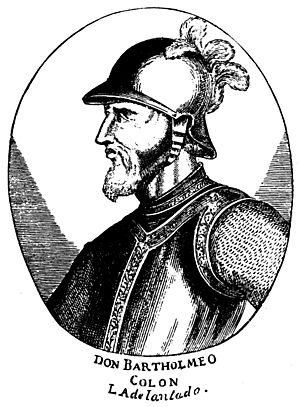Bartholomew Columbus facts for kids
Quick facts for kids
Bartholomew Columbus
|
|
|---|---|
 |
|
| Born |
Bartholomew Columbus
1461 |
| Died | 12 August 1514 (aged 53–54) |
| Parent(s) | Domenico Colombo Susanna Fontanarossa |
| Relatives | Christopher Columbus (brother) |
Bartholomew Columbus (Genoese: Bertomê Corombo; Portuguese: Bartolomeu Colombo; Spanish: Bartolomé Colón; Italian: Bartolomeo Colombo; c. 1461 – 1515) was an Italian explorer and mapmaker. He was the younger brother of the famous explorer Christopher Columbus. Bartholomew played an important part in his brother's plans and helped establish early European settlements in the Americas.
Contents
Life and Explorations
Bartholomew Columbus was born in Genoa, Italy. In the 1460s, he worked as a mapmaker in Lisbon, Portugal. Lisbon was a major center for making maps at that time. He and his brother Christopher came up with a big idea. They called it the "Enterprise of the Indies." This was a plan to reach Asia and its valuable spice trade by sailing west across the ocean. They hoped to find a new, faster route.
Seeking Support for the Journey
In 1489, Bartholomew traveled to England. He wanted to ask King Henry VII for help with their expedition. Unfortunately, pirates attacked his ship. He arrived in England with nothing. When he met the King, his request was not successful. He then tried to get help from King Charles VIII in France. This attempt also failed.
Meanwhile, his brother Christopher was in Castile, Spain. Christopher was trying to convince Isabella I of Castile and Ferdinand II of Aragon to support the voyage. In 1493, Bartholomew heard good news. His brother had succeeded in getting royal support! Bartholomew quickly returned to Spain. However, he missed Christopher. Christopher had already left on his second voyage to the "New World".
Journey to the New World
The Spanish Crown helped Bartholomew travel to Hispaniola in 1494. There, he finally met his brother. Christopher appointed Bartholomew as an Adelantado. This was a high-ranking governor position. Bartholomew held this role when Christopher was away. Between 1496 and 1498, he founded the city of Santo Domingo on Hispaniola. Today, Santo Domingo is the capital of the Dominican Republic.
Later, Bartholomew was imprisoned with Christopher and another brother, Giacomo (also called Diego). They were sent back to Spain in December 1500. After the Spanish Court cleared Christopher of the charges, the Crown funded Christopher's fourth and last voyage. This trip was to the West Indies. Bartholomew joined his brother on this final journey. He was meant to stay with a small group of soldiers near the Belén River. However, local people led by El Quibían attacked Bartholomew's men.
First Contact with the Maya
On July 30, 1502, they reached Guanaja. This island is part of the Bay Islands off the coast of Honduras. Christopher sent Bartholomew to explore the island. While Bartholomew was exploring, a large trading canoe approached. Bartholomew Columbus boarded the canoe. He found it was a Maya trading vessel from Yucatán. The Maya people were well-dressed and carried many valuable goods.
The Europeans took some of the cargo that interested them. They also took the elderly captain to help them communicate. Then, the canoe was allowed to leave. This was the first time Europeans had recorded contact with the Maya people. News of these new visitors likely spread along the Maya trade routes. Some ancient Maya prophecies about bearded visitors might have been recorded around this time.
Later Life and Death
After Christopher Columbus died in Spain in 1506, Bartholomew returned to the Antilles in 1509. He traveled with his nephew, Diego. However, Bartholomew soon went back to Spain. The King confirmed his right to Mona Island, near Puerto Rico. Bartholomew died on August 12, 1514. By then, he had returned to Hispaniola. After his death, the King took Mona Island back from Bartholomew's family.
Legacy
The island of Saint Barthélemy in the Caribbean was named in his honor. Christopher Columbus named it after his brother.
See also
 In Spanish: Bartolomé Colón para niños
In Spanish: Bartolomé Colón para niños

